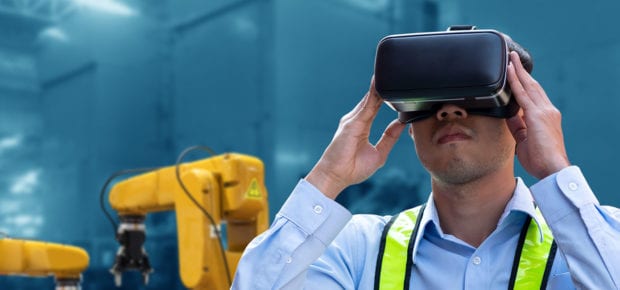June 4, 2020
There is no doubt that COVID-19 is impacting how we now live and work. Technology has enabled us to continue business from home and has helped us stay healthy while we continue our social distancing measures.
The fourth industrial revolution – also known as Industry 4.0 – has already begun. But we wondered how this pandemic may impact the future of technology, innovation and the workplace for future generations? We reached out to expert Lee Coulter, IEEE Working Group Chair on Standards for Intelligent Process Automation, for the answers:
IEEE: Because we are testing and utilizing technology in a different way during COVID-19, how will the fourth industrial revolution be impacted?
Lee Coulter: Throughout humankind’s history, there have been periods of crisis and conflict that stimulate innovation and motivate mass adoption. Threats, whether from war or famine or disease have massively advanced innovation. As the old saying goes, “necessity is the mother of invention.”
In 2020, the reality of exponential technology being applied in almost every facet of life puts both the innovation and adoption on an exponential curve. The instantaneous ability to collaborate, communicate and co-innovate further accelerate us toward Industry 4.0. Specialization (enabled by agriculture) plus collaboration = innovation. We have advanced global collaboration on a scale that will be studied for decades.
For example, this particular event forced the adoption of remote work. Billions of people realized in just 60 days that work can be done successfully via tele-presence technologies.
IEEE: Do you think COVID-19 will spark the beginning of industry 5.0?
LC:The ability to separate industry paradigms is beginning to fade because humanity is living on an exponential curve. When it began a couple of hundred years ago, the exponential nature was not visible. It is hard to see the doubling of 0.0000001 to 0.0000002.
Today, the only way to see it is by looking at data. This crisis accelerates us. It creates mass adoption of new technology and a flow of venture money into next generation technologies that will probably be studied in the future. Industry 5.0 is generally thought to start somewhere around the singularity. That is when machines will make better new machines than humans can among other things. Depending on whose data you like, that’s about ten years away.
Did this pandemic accelerate us toward the already inevitable Industry 5.0? Yes. But I believe it will only be historians looking at data 30 years from now that will be able to gauge by how much.
IEEE: There is conversation around the idea of transitioning to a fully lights-out factory, or fully automated factory, to keep production lines going during this time. What are the benefits and downsides to this type of factory?
LC: Lights out factories are here now; they just exist in a limited fashion in many industries. The only thing standing before us is how to maintain and improve the factories in a lights-out fashion and that is being solved by a number of things: advanced materials increasing durability, and self-healing systems (topic for another article). It is maintenance and improvement where today, we find few suitable substitutes for people at this moment in time.
The advances are everywhere in every industry. The convergence of these technologies is likewise inevitable. The gating factor is humankind’s capacity for change.
The downsides are part of our daily conversation. We don’t yet know how it’s going to work yet, but we are headed there nonetheless. The biggest downsides are amplified by an often dystopian media looking at our future. What they forget is that we have solved for every challenge humanity has ever faced before.
IEEE: How will offices be impacted by COVID-19? What future technologies do you predict us utilizing in corporate environments going forward?
LC: Two words: decentralization and dual-use. When consumers can live anywhere, many will choose to have a larger, less expensive home where they can both live and work. The number of companies making statements about the future of their corporate real estate footprints is not idle chatter. This is a shift. Two major real estate apps have declared for the first time, a reversal of urbanization. Employees and leadership are realizing that business does actually continue. There is more to work out for sure, but the crest of the wave is behind us.
Virtual reality and augmented reality will see rapid advancement as corporations demand more sophisticated, at-a-distance collaboration tools. These things exist today; all we needed was an impetus to change our behavior. I believe holographic displays and immersive collaboration spaces enabled by tele-presence technologies will see a huge market increase.
Of course, to enable this, telecommunications must transform to support this new demand. We will see a dramatic change to the way business is done. A B2B sale used to require a handshake at an expensive steakhouse; now, it will be done through a food delivery app that serves the steak and wine to people’s new home offices enabled by immersive collaboration spaces, that exist only on a server in a lights-out data center running on a self-healing network.
See also How Automation and the Fourth Industrial Revolution is Affecting Your Everyday Life
IEEE: Why is the IEEE 2755.1 standard now more important than ever?
LC: The IEEE 2755.1 – 2019 standard (IEEE Guide for Taxonomy for Intelligent Process Automation Product Features and Functionality) is more useful now than ever before. As companies are reevaluating their processes and the way work gets done, automation is a key strategic enabler. IEEE 2755.1 provides a comprehensive and objective way to evaluate any technology in the intelligent automation space.
Assembled by experts from many of today’s largest robotic process automation and intelligent automation providers, anyone who is in a product evaluation phase or even wanting to have a detailed conversation with a vendor can use it as a structured conversation guide.
Both sides of a video conference can have the guide in hand, and go through the vendor’s self-assessment of the criteria and demo/explain how their product performs. When you can’t get in a conference room and look over a shoulder, having the standard to guide the eval process is invaluable.
IEEE 2755.1 is the first published industry standard that provides in-depth product selection and detail on each feature’s importance to guide large businesses in their selection process of automation platforms. Learn more about IEEE 2755.1 and its guidelines here.





 Meaningful Momentum or Running in Place?
Meaningful Momentum or Running in Place? AI Through Our Ages
AI Through Our Ages Liquid Infrastructure: Our Planet's Most Precious Resource
Liquid Infrastructure: Our Planet's Most Precious Resource The Impact of Technology in 2025
The Impact of Technology in 2025 Quantum and AI: Safeguards or Threats to Cybersecurity?
Quantum and AI: Safeguards or Threats to Cybersecurity? Why AI Can't Live Without Us
Why AI Can't Live Without Us Bits, Bytes, Buildings and Bridges: Digital-Driven Infrastructure
Bits, Bytes, Buildings and Bridges: Digital-Driven Infrastructure Impact of Technology in 2024
Impact of Technology in 2024 Emerging AI Cybersecurity Challenges and Solutions
Emerging AI Cybersecurity Challenges and Solutions The Skies are Unlimited
The Skies are Unlimited Smart Cities 2030: How Tech is Reshaping Urbanscapes
Smart Cities 2030: How Tech is Reshaping Urbanscapes Impact of Technology 2023
Impact of Technology 2023 Cybersecurity for Life-Changing Innovations
Cybersecurity for Life-Changing Innovations Smarter Wearables Healthier Life
Smarter Wearables Healthier Life Infrastructure In Motion
Infrastructure In Motion The Impact of Tech in 2022 and Beyond
The Impact of Tech in 2022 and Beyond Cybersecurity, Technology and Protecting Our World
Cybersecurity, Technology and Protecting Our World How Technology Helps us Understand Our Health and Wellness
How Technology Helps us Understand Our Health and Wellness The Resilience of Humanity
The Resilience of Humanity Harnessing and Sustaining our Natural Resources
Harnessing and Sustaining our Natural Resources Creating Healthy Spaces Through Technology
Creating Healthy Spaces Through Technology Exceptional Infrastructure Challenges, Technology and Humanity
Exceptional Infrastructure Challenges, Technology and Humanity The Global Impact of IEEE's 802 Standards
The Global Impact of IEEE's 802 Standards Scenes of our Cyber Lives: The Security Threats and Technology Solutions Protecting Us
Scenes of our Cyber Lives: The Security Threats and Technology Solutions Protecting Us How Millennial Parents are Embracing Health and Wellness Technologies for Their Generation Alpha Kids
How Millennial Parents are Embracing Health and Wellness Technologies for Their Generation Alpha Kids Space Exploration, Technology and Our Lives
Space Exploration, Technology and Our Lives Global Innovation and the Environment
Global Innovation and the Environment How Technology, Privacy and Security are Changing Each Other (And Us)
How Technology, Privacy and Security are Changing Each Other (And Us) Find us in booth 31506, LVCC South Hall 3 and experience the Technology Moon Walk
Find us in booth 31506, LVCC South Hall 3 and experience the Technology Moon Walk Virtual and Mixed Reality
Virtual and Mixed Reality How Robots are Improving our Health
How Robots are Improving our Health IEEE Experts and the Robots They are Teaching
IEEE Experts and the Robots They are Teaching See how millennial parents around the world see AI impacting the lives of their tech-infused offspring
See how millennial parents around the world see AI impacting the lives of their tech-infused offspring Take the journey from farm to table and learn how IoT will help us reach the rising demand for food production
Take the journey from farm to table and learn how IoT will help us reach the rising demand for food production Watch technical experts discuss the latest cyber threats
Watch technical experts discuss the latest cyber threats Explore how researchers, teachers, explorers, healthcare and medical professionals use immersive technologies
Explore how researchers, teachers, explorers, healthcare and medical professionals use immersive technologies Follow the timeline to see how Generation AI will be impacted by technology
Follow the timeline to see how Generation AI will be impacted by technology Learn how your IoT data can be used by experiencing a day in a connected life
Learn how your IoT data can be used by experiencing a day in a connected life Listen to technical experts discuss the biggest security threats today
Listen to technical experts discuss the biggest security threats today See how tech has influenced and evolved with the Games
See how tech has influenced and evolved with the Games Enter our virtual home to explore the IoT (Internet of Things) technologies
Enter our virtual home to explore the IoT (Internet of Things) technologies Explore an interactive map showcasing exciting innovations in robotics
Explore an interactive map showcasing exciting innovations in robotics Interactively explore A.I. in recent Hollywood movies
Interactively explore A.I. in recent Hollywood movies Get immersed in technologies that will improve patients' lives
Get immersed in technologies that will improve patients' lives